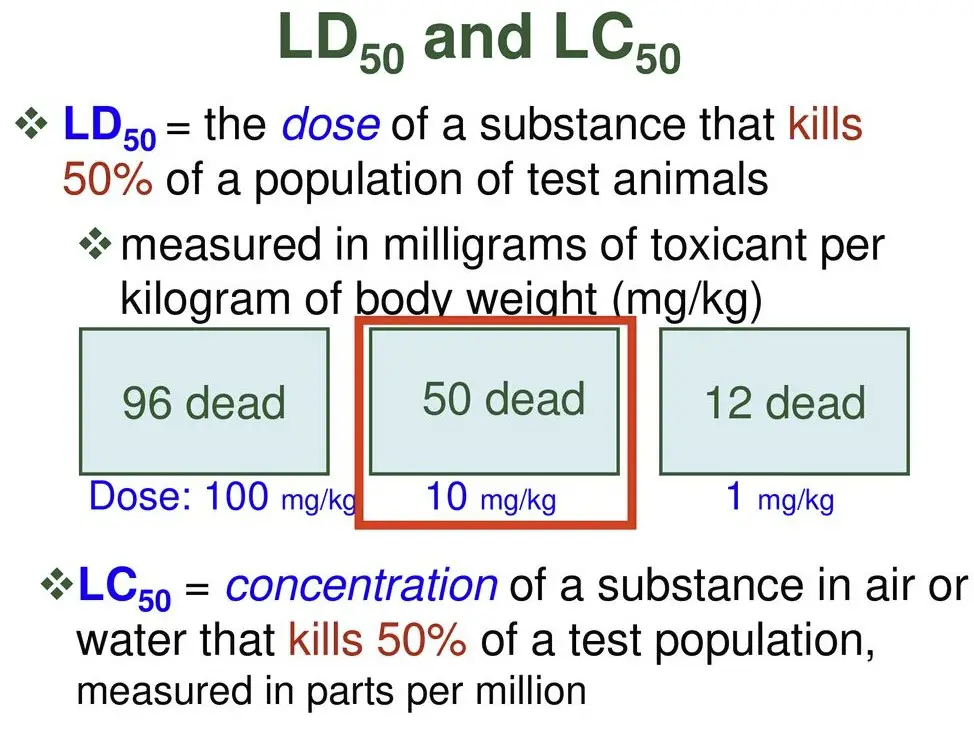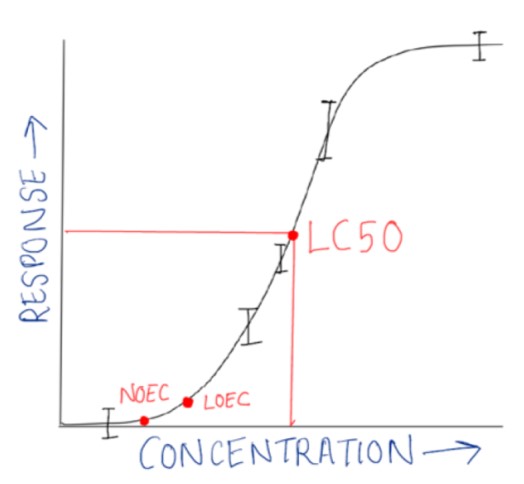Toxicity tests are essential tools in environmental and pharmacological sciences, aiming to evaluate the potential harm caused by chemicals to humans, animals, and the environment. Among these evaluations, LD50 and LC50 stand out as critical benchmarks. These measures provide a quantitative basis for understanding the lethal dose or concentration of a substance required to cause death in 50% of a test population under specific conditions.
The difference between LD50 and LC50 lies primarily in the medium through which the toxic substance is delivered. LD50, or lethal dose 50, refers to the amount of a substance (usually measured in milligrams of toxin per kilogram of body weight) that causes the death of 50% of a group of test organisms when ingested or injected. On the other hand, LC50, or lethal concentration 50, denotes the concentration of a substance in air or water that results in the death of 50% of a test population, typically measured over a specific time frame.
Understanding the distinctions between LD50 and LC50 is crucial for regulatory bodies, environmental scientists, and the pharmaceutical industry. These metrics help in assessing the risks associated with exposure to chemicals, facilitating the development of safety guidelines, and ensuring the protection of public health and environmental integrity.

Defining Terms
In the realm of toxicology and environmental science, two critical metrics are frequently used to quantify the potential harm of substances: LD50 and LC50. Understanding these terms is crucial for professionals and laypersons alike to grasp the implications of toxic exposure.
LD50 Explained
LD50, or Lethal Dose 50, is a statistical measure that represents the dose of a substance required to cause death in 50% of a tested population. This metric is commonly used to assess the toxicity of chemicals, medications, and other agents. It is expressed in milligrams of substance per kilogram of body weight (mg/kg), highlighting the potency of a compound.
LC50 Explained
Conversely, LC50, or Lethal Concentration 50, measures the concentration of a substance in air or water that kills 50% of a test population. This concentration is usually noted over a specific time frame, typically 24 to 96 hours, and is vital for evaluating the environmental impact of pollutants. LC50 is measured in parts per million (ppm) or milligrams per liter (mg/L).
Measuring Toxicity
The procedures for measuring LD50 and LC50 are meticulously designed to provide accurate, reliable data about a substance’s toxicity. These methods vary slightly due to the differences in the nature of the measurements.
LD50 Measurement
Test Organisms
The selection of test organisms for LD50 measurements often includes rodents, such as rats or mice, due to their physiological similarities to humans and their manageable size and cost.
Procedure
The procedure for determining LD50 involves several key steps:
- Preparing varying doses of the substance.
- Administering these doses to groups of test organisms.
- Observing the organisms for a set period, typically 14 days.
- Calculating the dose that causes death in 50% of the test subjects.
LC50 Measurement
Test Organisms
For LC50 measurements, aquatic organisms like fish or daphnia are commonly used when assessing waterborne substances, while rodents may be used for air pollutants.
Procedure
Measuring LC50 involves:
- Exposing groups of organisms to different concentrations of a substance in water or air.
- Monitoring mortality over a specific time, usually between 24 to 96 hours.
- Determining the concentration that results in 50% mortality.
Applications
LD50 Uses
The LD50 metric is instrumental in various fields, including pharmacology, where it helps in drug development by identifying potential toxicity levels. It also aids in regulating the use of chemicals and pesticides, ensuring they are used safely and responsibly.
LC50 Uses
LC50 values are crucial for assessing the environmental impact of pollutants. They inform regulations on waste disposal and emissions, contributing to the protection of aquatic life and air quality.
Key Differences
Understanding the distinctions between LD50 and LC50 not only clarifies their specific applications but also emphasizes the importance of context in toxicology.
Basis of Measure
- LD50 is measured in terms of dose (amount ingested or injected).
- LC50 is measured in terms of concentration in an environment (air or water).
Application Areas
- LD50 is more relevant to pharmacology and chemical safety.
- LC50 is crucial for environmental health and regulation.
Test Conditions
- LD50 tests often involve direct ingestion or injection.
- LC50 tests involve exposure to an environment contaminated with the substance.
Species Variability
Genetic Makeup
Different species react uniquely to the same substance due to genetic diversity. This means a compound that’s mildly toxic to humans might be highly toxic to another organism, such as fish or rodents.
Physiological Differences
Variations in metabolism, absorption, and excretion of chemicals contribute to species variability. For instance, some species can metabolize toxins more efficiently, reducing their overall impact.
Exposure Time
Short-term vs. Long-term Exposure
- Short-term exposure to a toxin may cause acute effects, often reversible upon cessation of exposure.
- Long-term exposure can lead to chronic effects, including irreversible damage, showcasing the importance of duration in toxicity evaluation.
Environmental Conditions
Temperature and Humidity
Environmental factors like temperature and humidity can affect the toxicity of substances. Higher temperatures may increase absorption rates through the skin, while humidity can influence the concentration of airborne chemicals.
pH and Medium
The pH of the environment and the medium in which a chemical is present (air, water, soil) can also alter its toxicity. For example, acidic conditions can enhance the toxicity of certain chemicals.
Interpreting Values
Safety Margin
The gap between the LD50/LC50 values and the expected human exposure level is crucial. A larger safety margin indicates a lower risk, while a narrow margin suggests higher potential danger.
Comparative Analysis
Evaluating LD50/LC50 values across species and conditions helps scientists predict potential impacts on humans and the environment, guiding safety regulations.
Safety Implications
Risk Assessment
LD50 and LC50 values are fundamental in assessing chemical risks, guiding the creation of safety data sheets and labeling requirements to inform users about potential hazards.
Precautionary Measures
Knowing these values aids in developing appropriate protective gear and handling procedures to minimize exposure risks.
Regulatory Standards
Setting Limits
Regulatory agencies use LD50/LC50 data to establish permissible exposure limits and ban or restrict certain substances, ensuring public and environmental safety.
Harmonization Efforts
Efforts to harmonize standards globally aim to provide consistent safety measures and facilitate international trade in chemicals.
Challenges and Criticisms
Variability and Reliability
The variability in test conditions and species responses raises questions about the reliability and applicability of LD50 and LC50 values for human risk assessment.
Reproducibility
Differences in methodology can lead to inconsistent results, complicating the interpretation of toxicity data.
Ethical Concerns
Animal Welfare
The use of animals in toxicity testing raises significant ethical concerns, prompting a search for humane alternatives.
Moral Responsibility
The debate over the moral acceptability of sacrificing animal lives for safety testing highlights the need for ethical considerations in scientific research.
Alternative Methods
In Vitro Techniques
Developments in cell culture methods offer promising alternatives to animal testing, potentially reducing ethical concerns and improving reliability.
Computational Models
Advances in computer simulation and predictive modeling provide non-animal methods for toxicity prediction, though these techniques still require validation against empirical data.
Integrated Approaches
Combining traditional testing with alternative methods can improve accuracy and reduce animal use, moving towards more ethical and effective toxicity assessment practices.
Frequently Asked Questions
What is LD50 in toxicity testing?
LD50, or lethal dose 50, is a statistical measure used in toxicity testing to quantify the amount of a substance that, when administered to a group of test organisms, causes death in 50% of them. It is a critical value in toxicology that helps determine the potential hazard of chemicals and drugs.
How is LC50 measured?
LC50 is measured by exposing a group of test organisms to different concentrations of a toxic substance in air or water. The concentration that results in the death of 50% of the test population, usually within a specified period, is identified as the LC50. This measure is crucial for evaluating the environmental impact of pollutants.
Why are LD50 and LC50 important?
LD50 and LC50 are important because they provide quantifiable data on the toxicity of substances, enabling researchers and regulators to assess the potential risks to humans, animals, and the environment. These measures are fundamental in developing safety guidelines and regulatory standards for chemical exposure.
Can LD50 and LC50 values change?
Yes, LD50 and LC50 values can vary depending on several factors, including the species tested, age, gender, and environmental conditions. These variations highlight the importance of standardized testing conditions and the need for cautious interpretation of toxicity data.
Conclusion
The concepts of LD50 and LC50 serve as foundational pillars in the field of toxicology, offering essential insights into the potential risks posed by chemicals and pollutants. By quantifying the lethal doses and concentrations that affect 50% of a test population, these measures play a pivotal role in shaping safety regulations and protecting public health.
Understanding the intricacies of LD50 and LC50 not only aids in the assessment of chemical hazards but also underscores the ongoing need for ethical considerations and advancements in alternative testing methods. As science progresses, the hope is for more refined and humane approaches to toxicity testing, ensuring the safety of both humans and the environment.

